Caryl Hart's Blog
August 23, 2022
Teach Early Years Award Shortlist for The Girl who Planted Trees
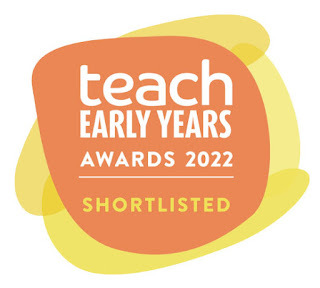
I'm delighted to announce that The Girl who Planted Trees has been shortlisted for the Teach Early Years Award, 2022!
Teach Early Years describe the shortlists as, "a wide variety of innovative resources - from STEM sets and literacy resources to CPD packages and picture books, and much more..."
Teach Early Years is a leading professional publication for early years teachers across the UK and features expert guidance, resources and training for the education sector.
Having our book shortlisted is a real achievement and I'm super-excited to hear the results in November. Fingers crossed!
To check out the other shortlisted books and resources, visit the Teach Early Years website.
February 2, 2022
Gaining Social Media Skillz
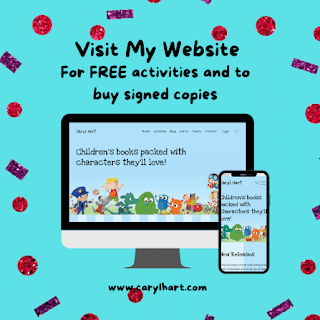
These past two weeks I have been working on my social media skills, kick-started by some great training with the fabulous Marita Oury Media, who is SO clued-up on what's hot and also happens to be a personal friend of many years.
For a long time I resisted splashing out on training, thinking I was doing perfectly well on my own, but more recently I've been feeling increasingly out of my depth and overwhelmed with all the jazzy content that is now expected.
Anyway, training done, apps downloaded and a LOT of mistakes made, I feel I'm now much more confident and am actually enjoying creating content rather than dreading it!
Do head over to my instagram and see what I've been up to... a few likes and shares would really give me a boost - it's been a massive challenge so I need all the encouragement I can get!
Also, watch out for more, fun content coming soon, as I build up to the publication of THREE NEW BOOKS!
July 20, 2021
Starting School with When a Dragon Goes to School

The lovely people at Magination Press asked me how When a Dragon Goes to School can help support families with children about to start school and those already in early years education. Head over to Magination Press to read the original article and also another interview I did about When a Dragon Comes to Stay
Here's a copy of the interview:
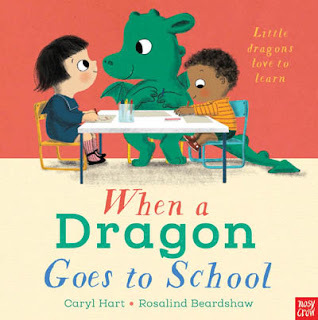
Starting school is a big milestone. Knowing what to expect can help ease that transition. Caryl Hart’s new book, When a Dragon Goes to School, follows a dragon as it explores the routines and manners that children, will experience in preschool. Magination Press asked the author about creating this delightful new picture book, which is a companion to When a Dragon Comes Stay.
Magination Press: What inspired you to write When a Dragon Goes to School ?
Caryl Hart: The first book in the series, When a Dragon Comes to Stay, was so popular that my publisher, Nosy Crow, asked if I’d like to write a second book where the little dragon starts school. Of course I said yes straight away!
I remember only too well how difficult it was to settle my own children into school when they were small – we had lots of tears and leg-clinging, which was hugely upsetting at the time. Little did I know that, while I felt terrible for the rest of the day, my girls skipped off to have fun as soon as I was out of sight!
Starting school is such a huge milestone for young children and creating fun, reassuring books is a great way to help prepare them. Our story includes common routines like hanging your coat and bag on a peg, entering the classroom, sitting in your special place, listening to the teacher and being kind to your new friends – all things that most children will experience during their first days at school.
Children who are already familiar with the school environment can sometimes struggle to talk about their experiences and might not know how to tell their grownups when things don’t go quite right. Reading books like When a Dragon Goes to School can help open up this dialogue and give children the tools they need to process difficult, exciting, or new experiences, ultimately helping them feel happy and safe.
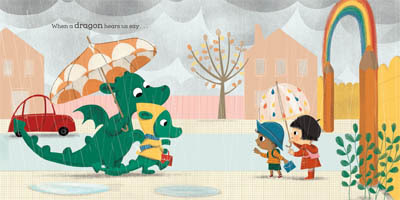
MP: Why are manners in school so important?
CH: Young children are often used to being the sole focus of attention at home, so learning to get along with others can be quite a challenge. Understanding school routines and learning to consider other people’s feelings help the school day run smoothly, which ultimately makes the experience a pleasant and rewarding one for everyone!
Most children do actually want to behave in a way that will please the adults in their lives, and modeling appropriate behavior in picture books can help them work out what is expected of them. Demonstrating funny scenarios of what would never do is a funny and endearing way to discuss the behaviors they are aiming for.
MP: Can you recall a teacher that you had in school who helped you learn good etiquette?
CH: I can’t remember anyone at school specifically teaching me about manners – my parents were pretty good at that! I think learning good manners is just part and parcel of the fabric of school life.
We raise our hands when we want to speak, we share our toys and equipment, we cooperate in our role play, we look at the teacher when they are talking…I’ve met many, many very patient teachers who reinforce this good behavior constantly throughout the day. And many, many fabulous children who know what is expected and delight in helping to create a positive atmosphere in their classrooms.
My favourite teacher at primary school was a lady called Mrs. Jack. She could play the guitar, and sing, and was great fun. We used to think she lived at school and I remember being very surprised when I saw her in the street once!
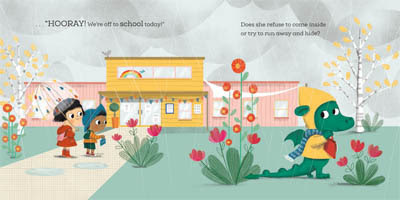
MP: Can you tell us a little bit about writing in verse? What is that process like?
CH: Writing in verse is different for every book. Sometimes I just start and see where the rhyme takes me, and other times, as for the When a Dragon series, I start with a pretty clear page plan, so I know what I’m going to talk about on every spread.
Then it’s a case of teasing out the words and experimenting with different combinations with the hope that I end up with a verse that tells the desired part of the story. Of course, it needs to rhyme, and also the rhythm, or scansion, has to match the pattern I’ve established for the book or series as a whole.
Getting the scansion right can be tricky, especially as people pronounce words differently. For example, do you say Princess or Princess? How you stress different syllables affects the way you read the story and therefore how it scans.
The most challenging part, however, is when my editor asks for tweaks or changes. It’s almost impossible to change just one word in a rhyming verse so any minor changes often require a total rewrite of the verse in question. I will often spend a whole day creating a single verse, so it can sometimes be difficult to go back and rewrite it – but I know that the end result will be better so I just have to take a deep breath and go for it!
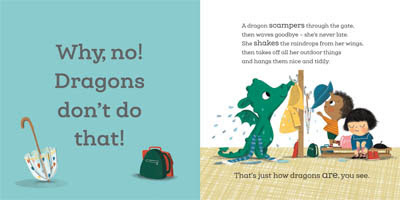
MP: Why did you choose a question-and-answer format for your Dragon books?
CH: This concept actually came from Nosy Crow – they came up with the idea of putting a Little Dragon into a home setting in the first book, When a Dragon Comes to Stay, to see what she would do. The refrain, “Why no! Dragon’s don’t do that!” was also their concept. All I had to do was create a story to fit!
I actually think this format works brilliantly as it gives young children a chance to think about how they might behave in certain situations. Or perhaps how their friends or siblings might behave. Children love to take the moral high ground and the When a Dragon books give little ones a perfect opportunity to identify the right way to go about things. It also gives us, as creators, an opportunity to inject a great deal of humor into the story and to show that, just like the little dragon, we are all still learning!
MP: What was the most fun part of creating When a Dragon Goes to School? What was the most challenging part?
CH: I hesitate to use the term “naughty” because I think it’s rather judgmental and negative, but the best bit about writing the book was thinking up some cheeky things that our little dragon might do when she started school. I wanted to choose things that young children would find funny and endearing without making our little character seem mean or unkind. I hope we succeeded!
With thanks to Magination Press for their support.
The lovely people at Magination Press asked me how When a...
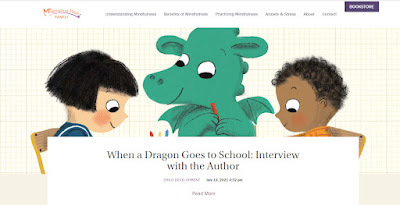
The lovely people at Magination Press asked me how When a Dragon Goes to School can help support families with children about to start school and those already in early years education. Head over to Magination Press to read the original article and also another interview I did about When a Dragon Comes to Stay Here's a copy of the interview:

Starting school is a big milestone. Knowing what to expect can help ease that transition. Caryl Hart’s new book, When a Dragon Goes to School, follows a dragon as it explores the routines and manners that children, will experience in preschool. Magination Press asked the author about creating this delightful new picture book, which is a companion to When a Dragon Comes Stay.
Magination Press: What inspired you to write When a Dragon Goes to School ?
Caryl Hart: The first book in the series, When a Dragon Comes to Stay, was so popular that my publisher, Nosy Crow, asked if I’d like to write a second book where the little dragon starts school. Of course I said yes straight away!
I remember only too well how difficult it was to settle my own children into school when they were small – we had lots of tears and leg-clinging, which was hugely upsetting at the time. Little did I know that, while I felt terrible for the rest of the day, my girls skipped off to have fun as soon as I was out of sight!
Starting school is such a huge milestone for young children and creating fun, reassuring books is a great way to help prepare them. Our story includes common routines like hanging your coat and bag on a peg, entering the classroom, sitting in your special place, listening to the teacher and being kind to your new friends – all things that most children will experience during their first days at school.
Children who are already familiar with the school environment can sometimes struggle to talk about their experiences and might not know how to tell their grownups when things don’t go quite right. Reading books like When a Dragon Goes to School can help open up this dialogue and give children the tools they need to process difficult, exciting, or new experiences, ultimately helping them feel happy and safe.

MP: Why are manners in school so important?
CH: Young children are often used to being the sole focus of attention at home, so learning to get along with others can be quite a challenge. Understanding school routines and learning to consider other people’s feelings help the school day run smoothly, which ultimately makes the experience a pleasant and rewarding one for everyone!
Most children do actually want to behave in a way that will please the adults in their lives, and modeling appropriate behavior in picture books can help them work out what is expected of them. Demonstrating funny scenarios of what would never do is a funny and endearing way to discuss the behaviors they are aiming for.
MP: Can you recall a teacher that you had in school who helped you learn good etiquette?
CH: I can’t remember anyone at school specifically teaching me about manners – my parents were pretty good at that! I think learning good manners is just part and parcel of the fabric of school life.
We raise our hands when we want to speak, we share our toys and equipment, we cooperate in our role play, we look at the teacher when they are talking…I’ve met many, many very patient teachers who reinforce this good behavior constantly throughout the day. And many, many fabulous children who know what is expected and delight in helping to create a positive atmosphere in their classrooms.
My favourite teacher at primary school was a lady called Mrs. Jack. She could play the guitar, and sing, and was great fun. We used to think she lived at school and I remember being very surprised when I saw her in the street once!

MP: Can you tell us a little bit about writing in verse? What is that process like?
CH: Writing in verse is different for every book. Sometimes I just start and see where the rhyme takes me, and other times, as for the When a Dragon series, I start with a pretty clear page plan, so I know what I’m going to talk about on every spread.
Then it’s a case of teasing out the words and experimenting with different combinations with the hope that I end up with a verse that tells the desired part of the story. Of course, it needs to rhyme, and also the rhythm, or scansion, has to match the pattern I’ve established for the book or series as a whole.
Getting the scansion right can be tricky, especially as people pronounce words differently. For example, do you say Princess or Princess? How you stress different syllables affects the way you read the story and therefore how it scans.
The most challenging part, however, is when my editor asks for tweaks or changes. It’s almost impossible to change just one word in a rhyming verse so any minor changes often require a total rewrite of the verse in question. I will often spend a whole day creating a single verse, so it can sometimes be difficult to go back and rewrite it – but I know that the end result will be better so I just have to take a deep breath and go for it!

MP: Why did you choose a question-and-answer format for your Dragon books?
CH: This concept actually came from Nosy Crow – they came up with the idea of putting a Little Dragon into a home setting in the first book, When a Dragon Comes to Stay, to see what she would do. The refrain, “Why no! Dragon’s don’t do that!” was also their concept. All I had to do was create a story to fit!
I actually think this format works brilliantly as it gives young children a chance to think about how they might behave in certain situations. Or perhaps how their friends or siblings might behave. Children love to take the moral high ground and the When a Dragon books give little ones a perfect opportunity to identify the right way to go about things. It also gives us, as creators, an opportunity to inject a great deal of humor into the story and to show that, just like the little dragon, we are all still learning!
MP: What was the most fun part of creating When a Dragon Goes to School? What was the most challenging part?
CH: I hesitate to use the term “naughty” because I think it’s rather judgmental and negative, but the best bit about writing the book was thinking up some cheeky things that our little dragon might do when she started school. I wanted to choose things that young children would find funny and endearing without making our little character seem mean or unkind. I hope we succeeded!
With thanks to Magination Press for their support.
June 29, 2021
Author Interview - Ivy's Library - A day in the life of an author

This year I've been overwhelmed with the amazing support from book enthusiasts and bloggers on social media.
I've been on Twitter for years but last May my journey into the book community on Instagram began. And what a journey!
I've found the bookstagram community to be hugely supportive and tirelessly enthusiastic about all children's books, including mine!
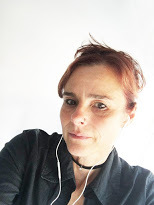
So I was delighted when Shelly from Ivy's Library asked me if I'd be up for an interview. She asked me to tell her fans about a typical day in an author's life. But life these days is far from typical so instead, I detailed some of the things I was doing over the course of a week including:running my fourth book promotion blog tourcreating wildlife poems for my role as Author in Residence for Nottinghamshire Libraries' umbrella organisation Inspire Culturespeaking with my agent and publishers about existing and new projectgrappling with my accounts!
You can read the full interview here
With HUGE thanks to Ivy's Library for all your help with my recent book launches!
Visit Ivy's Library Book Review Blog
April 14, 2021
Sonny Says MINE!

I am delighted to announce the publication of my new book with the superb illustrative talent that is Zachariah OHora.
Meet Sonny, Honey, Meemo and Boo and discover a pre-school world full of emotion and fun!
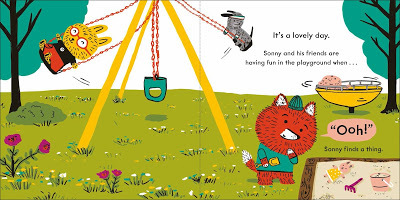
When you're small, learning to play together can be tricky and understanding other people's emotions can be a real challenge. Young children often upset each other without meaning to - it's just part of growing up and it's how children learn to develop empathy and understanding of others.
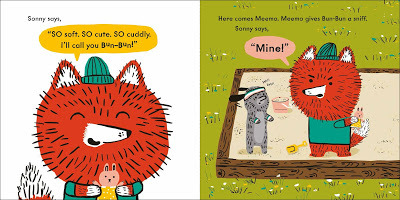
Sonny Says MINE! is the first in a brand new series for pre-school and younger children. This first book looks at the importance of sharing, and telling the truth - and helps children understand that being kind and considerate of others makes for happier friendships.
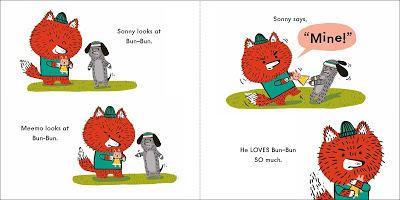
Sonny, Honey and Boo are all having fun in the playground when... Oooh! Sonny finds an adorable pink bunny. Sonny says, "MINE!" He calls it Bun-Bun and has a wonderful time playing with his new toy. But then Boo arrives. She is crying because she's lost her favourite pink bunny Suki. Oh dear.
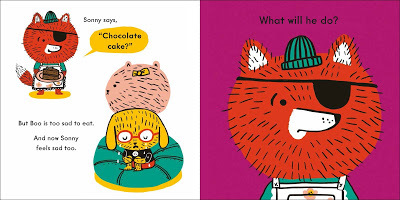
Will Sonny give Boo's bunny back?
Zachariah OHora's loveable illustrations are bright, bold and utterly adorable, so I'm delighted to be working with him on this series!
I'm excited to have an army of amazing book bloggers and reviewers helping me to launch Sonny Says MINE this week and next. Head over to my accounts on Instagram or Twitter to find out more!
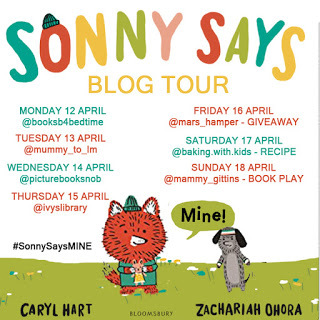

If you would like a personally signed copy of Sonny Says MINE! Head over to my online shop!
Sonny Says MINE! is published by Bloomsbury, 15 April 2021
April 8, 2021
Imagining History - How to Find Egyptian Treasure
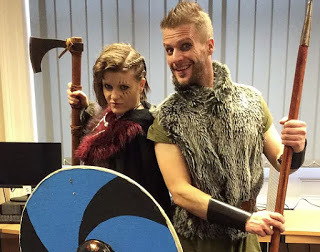
Imagining History provides award-winning, educational, history workshops for primary schools. Their interactive sessions combine role-play, storytelling, demonstrations and drama and performance to bring history to life for your students.
I was recently approached by co-owner Adrian Burrows who told me how much they love the Albie stories, and in particular the new titles, How to Find Egyptian Treasure and How to Drive a Roman Chariot. Adrian asked if I'd write a blog post for him about how I wrote and researched the stories.
You can read the post on Imagining History here.
Here it is reproduced for you below:
What was the inspiration behind the creation of Albie and his wonderfully varied stories?
When my children were young, we often went to the supermarket together, and I started to wonder how much more fun it might be to buy animals instead of cornflakes and washing powder. The result was Supermarket Zoo. The story was picked up by Simon and Schuster and published as a stand-alone title in 2009.
A year later, I was walking to our allotment with my friend Phoebe who was 2 years old. Phoebe asked me what I was going to grow, and I said carrots. When I asked Phoebe what SHE was going to grow, she said CHICKENS! It got me wondering what it would be like if you really could grow a chicken from a seed. Or, if you could grow something even more exciting! It was then I wrote How to Grow a Dinosaur! Initially I wasn't planning for this to be Albie's second adventure, but when my editor at Simon and Schuster read it, we all agreed that this would be the perfect story for Albie. Since then, Ed Eaves and I have created around one book every year, with book 11 due out this summer.

What do you love most about writing stories for children?
The best bit about creating picture books is seeing the stories come to life. It often takes me weeks or months and many, many rewrites to create a finished first draft. This is then laid out by a designer, then the illustrator, Ed Eaves in this case, will create some rough drawings to fill the pages.
Once these are all agreed by everyone, including me, the illustrator will create full colour images and the book is eventually printed. It's so exciting seeing the stories go from ideas in a notebook through all the various stages, to become a solid, beautiful book that you can hold in your hand!
The other amazing thing is when people tell me how much they love my stories. It's a deeply satisfying feeling for sure!
You deliver loads of brilliant school visits, both virtual and in-person, could you tell us a little more about these?
When we're not stuck at home because of covid, I visit schools around the UK, telling stories and helping children develop a love of books, reading and writing. I am often approached by teachers at the end of the day who tell me how much the children have loved my visit and how particular children have suddenly become motivated to write.
Many of the children I work with are from deprived backgrounds and may not have any books at home. Many live in communities with high unemployment and low aspirations. One of the things I try to do during my visits is to give children confidence that their own ideas are good ones and to show them that writing need not be an arduous task to be endured, but a joyful and exciting activity to share.
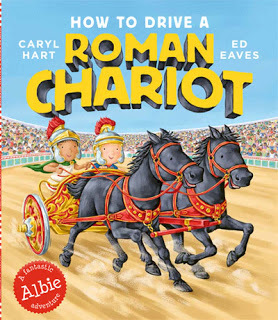
We've particularly enjoyed Albie's recent adventures in Ancient Egypt and Ancient Rome. What were some of the most interesting things you learnt about history from your research?
Well, did you know that there are around 120 pyramids in Egypt? I thought there were only four or five, so that was a big surprise! I also discovered that the ancient Egyptians farmed geese and oxen and used ploughs and sickles for growing and harvesting crops, which included leeks, salad, beans, figs and pomegranates.
As for the Ancient Romans, did you know that many girls were not allowed to go to school? Some had tutors at home but many were expected to learn only about housekeeping. I'm glad I didn't live in ancient Rome that's for sure!
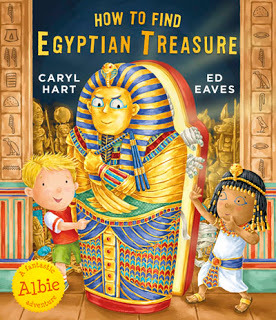
How to Find Egyptian Treasure is a really fun story, but it's also got loads of historical detail in it. There's the inclusion of the Sphinx, hieroglyphics to decode and even a teeny tiny Horus to find - was it tricky to balance the entertainment with the educational content in this or any other of your stories? What's the sweet spot?
Most of the historic content you talk about is shown in the illustrations. The text of the story doesn't mention many of these features by name. Ed Eaves has done a fabulous job of slipping all these details in without making too big a deal of it! We didn't want the stories to feel educational, we wanted them to be fun so that children might be motivated to find out more about what they see.
We wanted to fire up children's imaginations and help them picture how life might be for them if they lived in ancient times. Personally, I sometimes find fact books difficult to digest and the information hard to read about and remember.
For me, it's the human interaction that is the interesting bit. I like to focus on what it was like to live and play in those times, what people ate, what they did in their spare time, what they were afraid of and what they looked forward to. When you look at history in this way, you realise that the people from thousands of years ago were really just like us.
Everyone wants to love and be loved, to be entertained and challenged. Everyone wants to feel they are important and that they have a contribution to make in the world. By creating stories about ordinary people in different settings we can develop greater empathy and understanding for the real people around us, both within our communities and in the wider world.
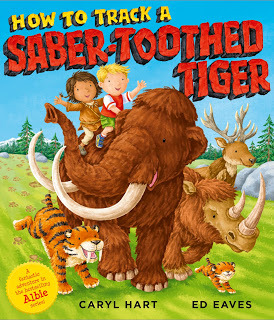
We've noticed that the next book in the series takes Albie to the Stone Age - can you give us a sneaky preview of what's in store for Albie and the gang?
I noticed on your website that you feature a stone age flute. Well, we also have a flute hidden in our story! There are also cave paintings like the ones archaeologists have found in Lascaux and LOTS of amazing prehistoric animals
In How to Track a Sabre Toothed Tiger, Albie finds a little striped kitten in his garden. He soon discovers that it belongs to a girl called Thorn. When the kitten runs away, Albie and Thorn search for tracks in the mud. Will they find the kitten or something a little larger?! Albie has recently celebrated his 10-year anniversary. Are there any other eras of history you are considering including in a future book? We'd love to see Albie on a Viking longship at some point!
Gosh, there are so many possibilities! I'd also love to write a Viking story, or one based on the Great Wall of China perhaps! The great thing about the Albie stories is that they all follow a similar pattern, so once you've read a few, you can have a go at writing your own! Perhaps your readers would like to try their hand at creating a brand new adventure of their own!
Find out more about Imagining History Here.
March 11, 2021
Meet the Oceans COLOURING COMPETITION!

Fancy winning yourself a SIGNED HARDBACK copy of Meet the Oceans? Just download a copy of this FAB colouring in activity created by @BethanWoollvin and post your finished piece to Twitter or Instagram as follows:
Instagram :Use the following hashtags:#MeettheOceansBookPlay#OceanbookplayTag:@carylhart @bethanwoollvin@bloomsburychildrensTwitter :Find my PINNED TWEET at the top of my profileAdd a photo of your entry in the comments below that tweet.Caryl Hart Twitter: @carylhart1
DOWNLOAD THE ACTIVITY SHEET HERE: https://www.carylhart.com/books/meet-the-world/meet-the-oceans
ENDS Sunday 14 March, 23.59 GMT. UK only.
This competition is in no way associated with Instagram or Twitter.BEWARE SCAMMERS! We will NEVER ask you for payment or bank details in connection with this or any other promotion.
GOOD LUCK!
March 4, 2021
Caryl Hart & Bethan Woollvin Interview each other! PLUS an EXCLUSIVE Artwork GIVEAWAY!
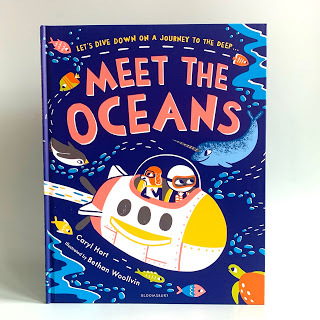
Meet the Oceans by me and Bethan Woollvin publishes TODAY!
To celebrate, Bethan and have interviewed each other about the creation of this book and our thoughts for the series.

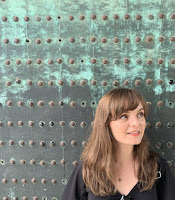
Here's our conversation:
Me: The Meet the World series (as I like to call it) started life in 2016 after Emma Blackburn, our Editor at Bloomsbury, saw some animated gifs of planets with little faces that you had on your website. She asked if I'd be interested in developing a rhyming book about a journey through space, with a rhyme for each planet, using your illustrations.

Q: What inspired you to create these cute little characters?
Bethan: Well, I think I had actually created these little planet characters as part of a project I was working on at university, back in 2015. They started off as small little doodles of planets, and I challenged myself to animate each planet into a small GiF. Animating the solar system, if you will!
Q: When you were writing your brilliant rhymes for Meet the Planets, were you thinking about how I might illustrate your story?
Me: I knew you'd be creating characters of the planets with cute little faces but I had no idea how you were going to present these. I love the way you play with perspective and your scenery, with those zingy neon highlights, looks stunning. Also for some reason, I didn't realise the background of the book would be jet black! The contrast between the colours you use and this very matt, black background really makes this book stand out.
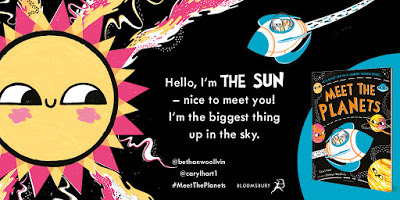
Q: Did you ever imagine that your little planet animations would be the start of this amazing project?
Bethan: A lot of my ideas and projects really begin with me finding an object, creature or person which demands its own character, and that’s really how the creation of my planet illustrations and animations came about. But when I first saw how you had written these rhymes, giving each planet their own personality and characteristics, it really kicked my imagination into overdrive! I had no idea that they would snowball into this fantastic series, but I’m really pleased they did.
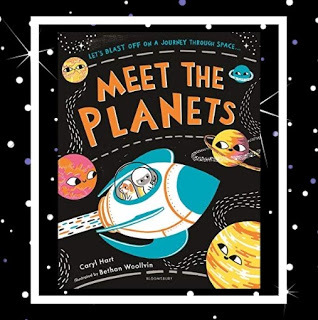
Q: All the research you put together for Meet the Oceans must have been a lot of hard work! How long did it take you to write the text?
Me: It actually took me several months to come up with the final text. It was a huge challenge deciding which facts to include. I wanted to pick details that could be used to create a personality for each ocean. With only four to eight lines to play with, I had to choose carefully!
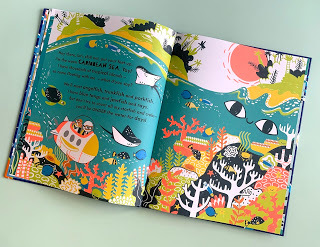
Q: When you first saw the text for Meet the Oceans, what was your initial reaction?
Bethan: Sitting down and reading your text for Meet the Oceans for the first time instantly set my brain off, working out exactly how I might bring these oceans to life! Being a visual thinker, I do a lot of designing and planning within my brain alone, and that definitely happened for me the moment I read your text! I think I knew immediately that it was going to be a huge challenge, but I couldn’t wait to get started.

Q: Your text for Meet the Oceans was very inspiring, and I had great fun creating the illustrations for the story. When you first saw my illustrations, what did you think?
Me: I had no idea how you were going to illustrate bodies of salt water as characters but you've done an amazing job of giving them all personalities. You've put so much detail into each image, with dozens of cute sea creatures for readers to spot! I love also that not every illustration is just a view of the sea bed. Some include bits of shoreline and the wildlife that lives beside the sea as well as in it. The way you transition from what is above water to what is below, is really clever!
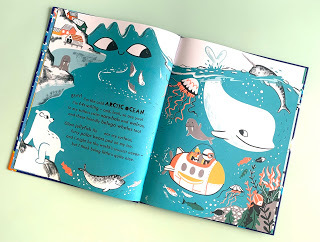
Q: How did you come up with this magical approach to the overall design of each illustration?
Bethan: It became evident quite early on during the planning stages of the illustrations that the depictions of each ocean and sea would need to be quite visually different to one another in order to keep the story flowing. After quite a lot of brainstorming sessions with our designer, Goldy, we figured out that using things like scale, colour and varying points of view, we could display each ocean and sea in really exciting ways.
There are some oceans within the book, for example, where I needed to illustrate both above water and below water, to show creatures diving into the water as well as the sea beds. Now luckily, with my style of illustration, I’m able to break a fair amount of perspective rules, which certainly came in handy!
Having a colour palette was also very helpful when creating these illustrations for Meet the Oceans. We had a wider palette, which included colours used across the whole book, but for each spread we picked just a few from that palette, depending on the type of ocean and it’s characteristics. I remember spending a really long time working out what shade of blue or green each ocean *felt* like, which was surprisingly tricky.
Q: All of your oceans and seas are such fantastic characters, which one was your favourite to write about?
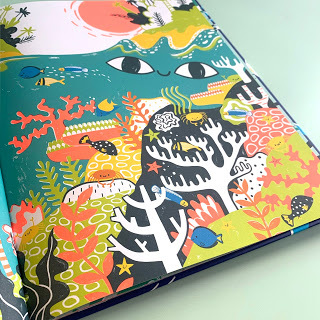
Q: All of your oceans and seas are such fantastic characters, which one was your favourite to write about?
Me: I think I enjoyed writing the Caribbean Sea rhymes the most, mainly because of the wonderful array of crazy fish names! There were literally so fabulous sounding fish, it was hard to choose, but in the end I went for: Trunkfish, Porkfish, Blue Tags and Jawfish... how evocative these names are!

Q: Which is YOUR favourite ocean or sea, and why?
Bethan: I think my favourite sea has to be the Mediterranean Sea. It was a particularly challenging spread, as it featured a tricky perspective of above and below the sea. But I really enjoyed illustrating all of the gorgeous Mediterranean homes on the coast, as well as that hot pink sunset and all the waving creatures. What fun it was to create!
Q: Writing can be really challenging, but even more so when you’re making the words rhyme too! Did you have trouble with any of the oceans or seas making the rhymes work?
Me: Honestly, it was really hard! It took me a really long time to get every verse right. It was tricky finding words with the right number of syllables needed to keep the rhythm even and flowing. There was a lot of chopping and changing to get to the point of a first draft. And then lots of re-writing following our editor's and designer's comments. When you write in rhyme, changing one word can often lead to re-writing the whole verse! We were also very keen to ensure each page picked out different aspects of the oceans and seas we were describing without too much repetition.

What was your biggest challenge creating this book?
Bethan: My biggest challenge for this book was keeping the balance of the characters right, and I used a lot of ‘primary’ and ‘secondary’ characters to tackle this - I’ll explain why. As your story personified each of the oceans and seas, it felt really important for them to have big eyes, full of expression. As well as the bodies of water, the little human and dog zooming around in their submarine also need more expressive eyes in order to react and interact with the oceans. But what about all of the creatures you wrote about in your story?! They’re important, too! Well, it quickly became apparent that if every creature in the whole book had that sneaky side eye, you wouldn’t know where to look on each page! It would be full of eyes!
So we decided that we would assign larger eyes to some of the bigger ‘primary’ characters, such as whales, seals and swordfish, and assign small dot eyes to the ‘secondary’ characters, which are mainly fish, crabs and seagulls. But that was certainly very challenging, and took quite a while to figure out.
Q: Our world has a lot of oceans and seas, so many that we couldn’t fit them all into the book! Were there any bodies of water that you nearly included in the book?
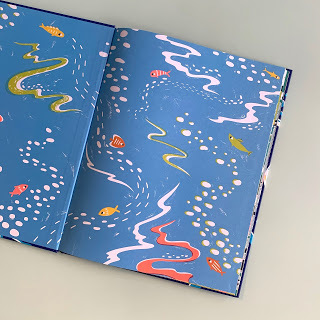
What about Meet the Oceans are you most proud of ?
Bethan: Well, I’m really proud of the project as a whole, because it pushed me to think outside the box and come up with something really fun and unique! But what i’m most proud of is the amount of movement I’ve been able to illustrate in this book. My illustration is very flat and static, and it was a real worry for me at the beginning of the project. How was I going to illustrate the oceans and seas, which are busy and brimming with life and movement?! But I rose to the challenge, and spent a really long time studying videos of water, bubbles, waves, swimming fish, seaweed, currents, coral and much more. This helped me endlessly throughout the book, as I was able to give the oceans much more texture and movement. It was certainly a lot of work, but I couldn’t be more proud of how I have brought the oceans and seas to life with my own drawings!
Q: While writing the text for Meet the Oceans, you must have squeezed in your favourite sea creature! What is your favourite sea creature?
Q: If you could choose any Meet the.. title to do next, what would it be?
Bethan: Good question! I think you could do something really fun with pond life, though I think I need a little more time away from drawing bodies of water, it might be the end of me! Aside from pond life, I think the natural wonders would be really fun. Volcanoes, mountains, waterfalls and so on. OR we could go really weird and do a book about time! I’d love to try and personify relativity and wormholes.
Q: I have the same question for you! If you could write any ‘Meet the…’ book next, what would it be?
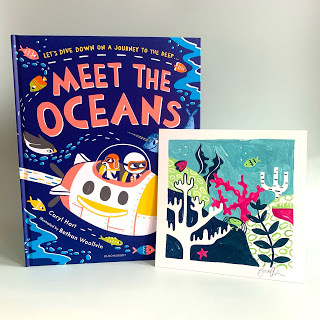
Bethan is giving away this STUNNING piece of original artwork to one lucky winner! To be in with a chance of winning, we want you to create a picture of a WHALE and post it on Twitter or Instagram, tagging Bethan and me.
Visit Caryl's Instagram : @carylhart1Visit Caryl's Twitter : @carylhart
Bethan's Instagram : @bethanwoollvinVisit Bethan's Twitter : @bethanwoollvin
Entries close Sunday 7 March, 23.59 GMT
The winner will be notified on Monday 8 March.UK only.
Note: This giveaway is in no way associated with Instagram or Twitter. Beware of scammers. We will never ask you for any payment in connection with this, or any other giveaway.
Meet the Oceans is published by Bloomsbury Children's Books, 4 March 2021
To buy a personally-signed copy, visit my SHOP.
February 26, 2021
Meet the Oceans - The Backstory
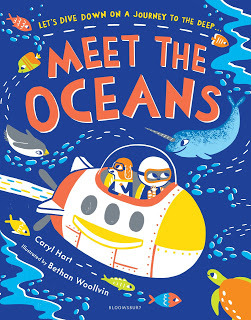
I'm delighted to have been asked by the Federation of Children's Book Groups (FCBG) to write a blog post about Meet the Oceans, the second book in my new series illustrated by the super awesome Bethan Woollvin.
Here's what I told them.
Meet the Oceans is a fabulous first look at the wonders of the underwater world for young children. Illustrated by the amazingly talented Bethan Woollvin, it takes readers on an exciting submarine adventure to meet some of our planet's oceans and seas.
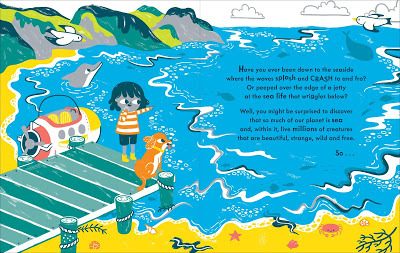
Each body of salty water has its own personality and a poem that highlights some of its wonderful wildlife, physical characteristics and human interactions.
So how did this book come about?
Meet the Oceans is the second book in a series which was launched last year with Meet the Planets, which is proving to be a very popular first look into space.
The series started life in September 2016, as some little animated gifs of friendly-faced planets on illustrator Bethan Woollvin's website.


I was not yet working with Bloomsbury at this point, but had a great relationship with Publishing Director, Emma Blackburn, who had arrived from Simon and Schuster the previous year.
Emma asked me if I'd be interested in writing a book of poems that introduced young children to the planets using Bethan's illustrations. Of course, I said yes straight away!
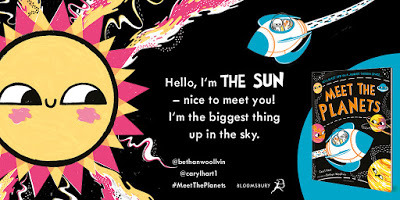
Bloomsbury featured Meet the Planets on their stand at the Bologna Children's Book Fair in 2019 and the book published last year, in 2020.
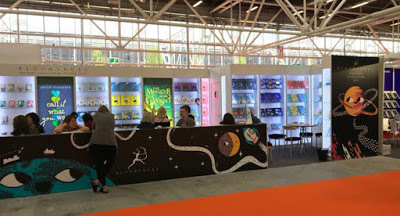
Most of the books I write are based purely on made up ideas from inside my own head. But with Meet the Oceans and the rest of this series, I needed to do a lot of research, which was a very different way of working for me.
I learned so much about the physical geography and wildlife of each ocean and about how humans use and impact on them. Picking out which aspects to focus on for each sea, and distilling all this information into four short lines, as well as deciding which oceans and seas to feature, was quite a challenge!
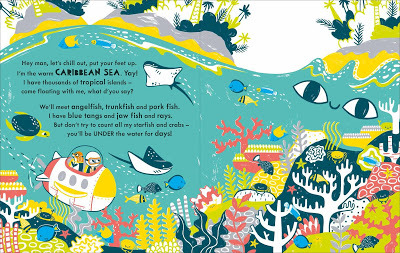
You might be surprised to discover that my degree was not in literature, but in Biology and I worked in environmental conservation for several years before becoming an author. So getting back to working on a book with an environmental theme was a real joy.
Many of environmental books and programmes we see these days focus so much on the damage that humans are doing that our sense of wonder and appreciation are completely overshadowed by the feelings of doom and gloom we are left with. While I absolutely believe that we need to arm our children with the skills, motivations and the will to address these issues, I did not want to use the book to add to his burden.
Instead, with Meet the Oceans, I was careful to avoid negative messaging, choosing instead to focus on stimulating curiosity and creating feelings of empathy, awe and compassion.
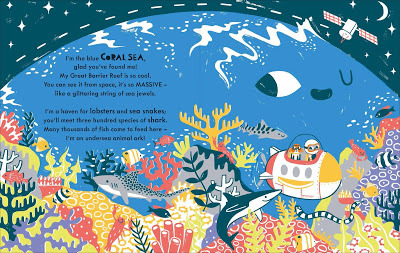
I want young children and their families to fall in love with our marine nature without feeling guilty or anxious about pollution and plastics. I believe love comes first. And once you love a thing, you will take steps to protect and care about it.

Adding faces onto planets is relatively straightforward, but I had no idea how Bethan Woollvin was going to illustrate the oceans as living characters. I think you'll agree she has done an exceptional job in bringing these watery worlds to life! Her zingy illustrations are packed with detail and by adding friendly eyes and cheeky smiles, she has really drawn out the personalities of each body of water.
I get lots of messages on social media from families telling me how their young children have learned many of the rhymes from Meet the Planets off by heart. Children have been baking planet-themed biscuits and creating their own planet characters using some of the activity sheets we've created for them.
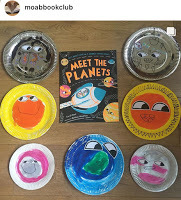
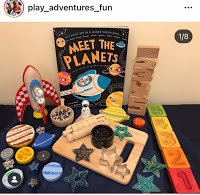
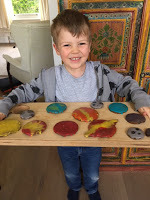
I'm hoping that our new book will be just as popular!
We are currently working on book three together and talking about where to take this series next. I can't wait!
Meet the Oceans is published by Bloomsbury and is out on 4 March, 2021
ISBN: 978-1526603647



